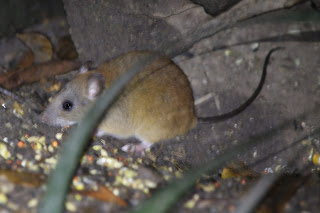I wanted a few photo ticks from far North Queensland of species that can only or most easily be seen in the wet season, so I flew to Cairns last week on a cheap Covid tourism industry recovery fare ($75!). A hire car (Apex is much cheaper than the big names) was picked up and I was off to the famed Kingfisher Park Lodge at Julatten. I’d not visited there before, but it’s arguably the best site in the country for Red-necked Crake. This time of year is the end of the dry season, hot and with little water about; the crakes (above and below) were seen easily with multiple encounters in forest fragments, on lawn edges and at bird baths. I saw them several times from my motel room deck (first image below). Another wet season visitor I was after (none of these targets were lifers) was Buff-breasted Paradise-Kingfisher. This glorious bird was happily common, with several active termite mound nests on the property and birds seemingly calling all over the place. Early the next morning I drove up to the grassy clearing atop Mt Lewis, the go-to site for Blue-faced Parrotfinch. They are not usually there in numbers until late in the wet season so this was a bit hit-and-miss, with just a single sighting of one bird on ebird this season. However, a parrotfinch was literally the first bird I saw in the gloomy light upon arrival. An adult and a subadult fortunately hung about until the light improved, exploring roadside seed along the rainforest edge. Other birds were somewhat hard to come by but I saw - among others - Chowchilla and Tooth-billed Bowerbird (below). Others included Bridled Honeyeater and Bower’s Shrike-thrush (below). Back at the lodge I spotlighted around the grounds that evening seeing several Bush-Rats (Rattus fuscipes) and Fawn-footed Melomys (above) and an obliging Giant White-tailed Rat (below). An Amethystine Python put in an appearance (above), as did a gaunt White-lipped Tree-frog (below). The next morning I had nice views of a male Superb Fruit-Dove. I headed north to Cooktown, stopping at a lagoon along Hurricane Road near Mt Carbine which can be productive. A pair of Squatter Pigeon by the road were unusually tame. At the lagoon was a vocal Brown Treecreeper of the distinctive north Queensland race melanotus. I was given a site for Spotted Whistling-Duck by my friends Kath Shurcliff and David Houghton at Keatings Lagoon near Cooktown. In very hot and humid conditions I tracked down a flock of 18 birds which kept to themselves in well-vegetated backwaters, showing no inclination to join the large numbers of Wandering Whistling-Ducks in more open areas. Also at the lagoon were a couple of Tropical Scrubwrens. The next morning I failed to connect with Black-winged Monarch along the road to Walker Bay (above) outside Cooktown, where they had been seen recently, although Kath heard one. I had to make do with a Yellow-spotted Honeyeater on its nest. Carlia longipes (Closed-litter Rainbow-skink) was common in the leaf litter. I drove south to Kuranda for an overnight stop with my friend Alexander Watson. A pair of Double-eyed Fig-Parrots showed beautifully at eye level by his back door. Many thanks to Alexander for lending me his camera for this trip after I dropped mine in a creek two days before leaving for Cairns! I moved on to Cairns. It took a couple of visits to the France Road turf farm to finally notch up Eastern Yellow Wagtail, which had been present here in recent weeks. The first of three birds seen eventually was well-picked up by Martin Cachard. In and about Cairns, Torresian Imperial-Pigeons were nesting everywhere. This migratory species once nested only on offshore islands, visiting the mainland to feed. An abundance of suitable food (palm fruit mostly) evidently accounts for the change in behaviour.
↧




























